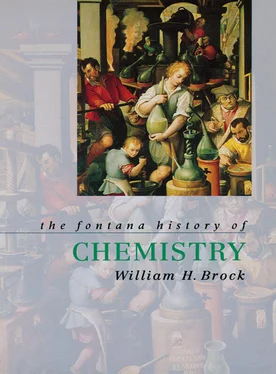There are a number of interesting features about these experiments and Helmont’s reasoning. Their most important feature is not that Helmont misinterpreted his observations because he ignored the role of air, but that they were quantitative. The experiments were also controlled. In the willow tree experiment, Helmont covered the vessel so as to prevent dust contamination, which might have affected the result. Similarly, he dried the earth beforehand and used only distilled water. He clearly had thought about the experiment and possible objections that might be raised against his conclusions because of the way the experiment had been designed. All this was the hallmark of the experimental method that was to lead to the transformation of chemistry. In addition, it is noticeable that he implicitly assumed that matter was conserved in any changes it underwent. When metals were dissolved in acids they were not destroyed, but were recoverable weight for weight. Helmont also postulated the existence of an alcahest , or universal solvent, which had the property of turning things back into water. Much time and effort was spent by contemporary chemists, including Robert Boyle, in trying to identify this mysterious solvent.
There is a further item of interest to be found in Helmont’s writings. Since air could not be turned into water, he accepted it as a separate element. However, his keen interest was awakened by the ‘air-like’ substances that were frequently evolved during chemical reactions. Helmont identified these fuliginous effluvia as ‘gases’, from a Greek word for ‘chaos’ that Paracelsus had ascribed to air in another connection. Where did these uncontrollable, dangerous materials fit in Helmont’s ontology?
Gases were simply water, not air, for any matter carried into the atmosphere was turned into gas by the cold and ‘death’ of its ferments. A gas was chaos because it bore no form. A gas might also condense to a vapour and fall as rain under the influence of blas , a term that did not stay in chemical language, and which Helmont coined to refer to a kind of ‘gravitational’, astral influence or power that caused motion and change throughout the universe.
In a typical gas experiment, Helmont heated 62 lb (28 kg) of charcoal in air and was left with 1 lb (2.2 kg) of ash, the rest having disappeared as ‘spiritus sylvester’ or wild spirit. When charcoal was heated in a sealed vessel, combustion would either not occur, or would occur with violence as the spirit escaped from the exploding vessel. This disruptive experience led to Helmont’s definition of gas :
This spirit, hitherto unknown, which can neither be retained in vessels nor reduced to a visible body … I call by the new name gas.
Although Helmont implied by this a distinction between gas and air, and even between different gases, these were features to which commentators paid scant attention. The reason for this is that, in the absence of any suitable apparatus to collect and study such aerial emissions, it was impossible to distinguish between them chemically. Helmont himself had to be content with classifying gases from their obvious physical properties: for example, the wild and unrestrainable gas (spiritus sylvester) obtained from charcoal; gases from fermentations; vegetable juices; from the action of vinegar on the shells of certain sea creatures; intestinal putrefactions; from mines, mineral waters and from certain caverns like the Grotto del Cane near Naples, which allowed men to breathe but extinguished the life of a dog.
In striking contrast to his French contemporary. René Descartes, who claimed that, apart from the existence of a human soul, life was a mechanistic process, Helmont refused to separate soul from matter itself. Matter became spiritualized and nature pantheistic. Such a spiritualization of matter proved especially attractive to various religious groups during the Puritan revolution in England. The writings of Paracelsus and Helmont circulated widely during the 1650s and 1660s, partly because they could be used as weapons in the power struggles between physicians and pharmacists, but also because religious ideology was in a state of flux. The Neoplatonic, unmechanical, vitalistic and almost anti-rational aspects of both Paracelsianism and Helmontianism appealed to many because they emphasized the significance of personal illumination against pure reason. This appealed to the Puritan conscience precisely because it could justify religious and political revolution for the sake of one’s ideals.
But along with the ideology went the ‘positive’ science of Helmont: gases, quantification and measurement, and iatrochemistry. Once the Commonwealth was achieved, the concept of personal illumination had to be played down (as Libavius had foreseen) in order to prevent anarchy. In the 1660s, therefore, Helmontianism came under attack. Whereas in the 1640s it had been argued by some that Oxford and Cambridge Universities ought to be reformed under Paracelsian and Helmontian lines, by the mid 1660s this was out of the question and the mechanical philosophy of Descartes, Boyle and Newton was to be triumphantly advocated by the new Royal Society. Nevertheless, echoes of Helmontianism remained in the works of Boyle and Newton.
This dualistic theory, based upon the old Empedoclean idea of a war of opposites, also stemmed directly from Helmont’s work. Helmont had explained digestion chemically as a fermentation process involving an acid under the control of a Paracelsian archeus or internal alchemist. At the same time, he was able to show that the human body secreted alkaline materials such as bile. One of his disciples, Franciscus Sylvius (1614–72), a Professor of Medicine at Leyden from 1658 until his death, and a leading exponent of iatrochemistry, extended Helmont’s digestion theory by arguing that it involved the fermentation of food, saliva, bile and pancreatic juices. For Sylvius, this was a ‘natural’ chemical process and involved no archeus, supernatural or astral mechanism of transformation. The pancreatic juices were a recent discovery of physiologists. By taste they were acidic, as was saliva; but bile was alkaline. Since it was well known that effervescence was produced when an acid and alkali reacted together, as when vinegar was poured onto chalk, Sylvius believed that digestion was a warfare, followed by neutralization, between acids and alkalis.
He did not hesitate to extend this conception of neutralization between two chemical opposites to other physiological processes. For example, by suggesting that blood contained an oily, volatile salt of bile (alkali), which reacted in the heart with blood containing acidic vital spirits, he explained how the vital animal heat was produced by effervescence. From this normal state of metabolism, pathological symptoms could be explained. All disease could be reduced to cases of super-acidity or super-alkalinity – a theory that was quickly exploited commercially by apothecaries and druggists and which is not unfamiliar from twentieth-century advertisements.
Sylvius’ theory was popularized by his Italian pupil, Otto Tachenius (1620–90), in the Hippocrates Chemicus (1666) – a title that advertised its iatrochemical approach explicitly. Amid its chemical explanations for human physiology lay a criticism that the greatest need in the 1660s was for a unifying theory of chemical classification and explanation to replace the tarnished hypotheses of the four elements and the three principles. Tachenius urged instead that physicians and chemists adopt a two-element theory that the properties and behaviour of substances lay in their acidity or alkalinity.
The fundamental problem with Tachenius’ suggestion was that there was no satisfactory definition of an acid or an alkali beyond a circular one that an acid effervesced with an alkali and vice versa.
Читать дальше












